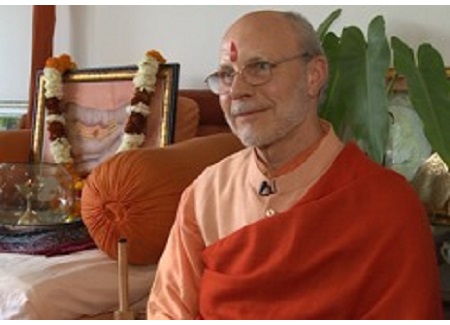
“2019 Sangha Gathering” by Swami Ritavan Bharati
2019 Sangha Gathering
by Swami Ritavan Bharati
[The video “Interview with Swami Ritavan Bharati” can be watched on YouTube. This is a transcript from the video. The video was recorded and edited by Lo, whom Tinyu Chen brought to Swami Rama Sadhaka Grama in March 2018.]
When we look to the future, we look at how can we create opportunities for students to deepen their practice or to become familiar with, to be introduced to practices that they may feel that now they are ready for, now they would like to understand themselves through such unique ways of these prayers, contemplations, meditation, yoga practices, so we’re coming together with a special gathering next year.
We are honoring Swami Veda in the sense of his beautiful little book, booklet, that he created for the United Nations presentation some years ago. Also for the Parliament of World Religions he gave a talk. He gave a theme that was simply called “The Perennial in the Millennium” for it was the change of the millennium. And he took these sentiments of how would one want to create a beautiful future, a peaceful future. Not only for oneself or one’s family or even among a community, but for the whole world. So he presented this at the United Nations. He presented these beautiful tools of insight and guidance for humanity if they so choose.
So we are going to gather a group together next year in the month of February and March to specifically review these themes of living, living with the sense of sustainability, with a sense of understanding Mother Earth’s ability to give and us as humans, not always taking, taking, taking, but to live in harmony with nature as a way by which we can see more of a beautiful future.
So with this the sangha, the members of the world organization, of the world communities, coming together for the AHYMSIN organization and serving the intention of Swami Veda before he left his life to inspire us for the future.
Also we have a number of traveling teachers so we continue to provide the instruction and the guidance, either by the way of seminars or programs or by way of teacher training. And again our unique way of training yoga teachers is to see yoga in ten different fields of knowledge, so we work with the entire scope of a, let’s say, an understanding of yoga. What is the philosophy and the psychology or the texts and the scriptures or through one’s sadhana or through the tradition of the yoga lineage or through the asanas in the anatomy of the body, or through the pranayamas in the understanding of the breath practices that lead to meditation as well as the meditative states and the very specific tools of relaxation and in that way concentration that leads to meditation. These once again the context of the yoga philosophy that has been given to us through Patanjali in the Yoga Sutras. This is simply to say that yoga means samadhi. The purpose of yoga is samadhi, that state of harmony, unity, and oneness within one’s true nature.
So we continue to guide perspective teachers that would like to learn the practices in our tradition, teach yoga, but mostly practice, so that they really can provide guidance for their students in the future.
You know that in the paths of yoga, there are many paths that all lead to the same mountain top. Some are always wanting to read and to feel that connection that ideas can give them and in that way apply that in their life. Others like to be more active, more involved, more sharing with others, giving to others, working for others in the sense of a collective effort, and we say that’s the karma yoga, and in that way they understand through the acts of service and seva. Also one, they have more of an emotional character, which then bhakti yoga is able to guide them in the paths of making that object of their emotion and of their sentiment a divine purpose either within the recognition of the divine in the other person or through their own prayer life that deepens through this deep sentiment called bhakti yoga. So these tools of the yoga practice, of the paths of yoga. And then using the modern methods, let’s say, the ways in which over the internet now you have so many ways to view videos, to hear audios, to examine some of the Sanskrit texts or the language in which the texts have been written, the Sanskrit language, and in that way begin a sense of study.
But there should always be a sense of coming back to a guide, a guide that can form fit. You go to a shoe shop, and you say, you just don’t say give me a shoe and pull anything off. You say, “Do you have someone that can measure my foot?”, and so they measure it. “Yes, you need this. This is best for you.” So in that way the yoga guide is so important and in that way whatever you’re collecting by way of means and practices will be fine tuned through the guide and applied then for your effortless journey on this spiritual journey.



